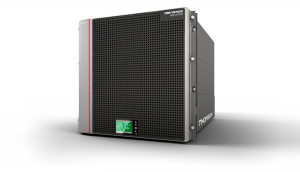Dressed to compress – can HEVC transform multiscreen TV?
HEVC or H.265 is being heralded as the next generation of video compression technology, with uptake likely to be accelerated by the explosion in tablet use. Stuart Thomson reports.
 Compression vendors used the NAB show in April to highlight their early-stage High-Efficiency Video Codec (HEVC) implementations, with vendors in the space looking to live and offline OTT HD and SD video-on-demand for multiscreen devices, with software decode capability, as the key initial application. Vendors including Thomson Video Networks and Motorola however also highlighted their ability to support offline encoding for 4K VOD applications.
Compression vendors used the NAB show in April to highlight their early-stage High-Efficiency Video Codec (HEVC) implementations, with vendors in the space looking to live and offline OTT HD and SD video-on-demand for multiscreen devices, with software decode capability, as the key initial application. Vendors including Thomson Video Networks and Motorola however also highlighted their ability to support offline encoding for 4K VOD applications.
Multiscreen OTT
The promise of the new video compression standard (also known as H.265) has clearly excited many in the vendor community, and most have focused on multiscreen OTT and mobile video as the key early stage application rather than 4K TV. The advantage of HEVC over previous next-generation compression technologies is that it can be decoded in software on the latest generation of tablets and smartphones, meaning that there is an immediate application for the technology without a need to swap out a generation of set-top boxes from consumers’ homes. However, some voices remain sceptical.
HD OTT to mutliple screens is likely to be the key initial application for HEVC, but 4K video-on-demand also presents a possible route to exploit the new technology, according to Tom Lattie, vice-president, product marketing, Harmonic. Lattie says that HEVC could enable the delivery of full-resolution HD OTT services at under 3Mbps. Moreover, many of these services could be delivered via hybrid devices such as the latest version of the Apple TV box to TV screens.
“Mobile OTT services are actually going to TVs,” he says. “HEVC could enable these suppliers to move past the pay TV operators direct to TVs.”
Lattie says that HEVC could achieve far faster uptake than had been the case with MPEG-4 AVC, because there are already many devices deployed that could decode HEVC in software. Unlike the deployment of H264, it is now the case that mobile devices including tablets and smartphones, rather than set-top boxes, have ARM cores that provide the ability to decode HEVC.
“Software-based decoding is now possible and every device can potentially be an HEVC decoder,” says Lattie.
According to Keith Wymbs, vice-president of marketing at video processing specialist Elemental Technologies, multiscreen will drive interest in HEVC because “every bit is charged for on the delivery side” by CDN providers. This means that the return on investment period for purchasing equipment that reduced the number of bits required to deliver the video is very short.
Elemental was an early adopter of HEVC and provided a demo at last year’s IBC based on its own codec rather than the standard reference codec, provided by the specification. Initially, it provided file-based encoding, but showed 1080p30 video encoded in real time at NAB. Since then, says Wymbs, the company has optimised its platform and reduced the bandwidth for HD video by a further 15-25%. “It looked good at 3.2Mbps,” he says, adding that Elemental is confident it will “be able to get to 50%” of the bandwidth required by H.264 over the next few releases of its codec. “We are in the early days of HEVC and we can see pretty drastic improvements over the course of the year,” he says.
Shared optimism
Other vendors clearly share this optimism about the technology. Ericsson this year launched what it described as the first LTE broadcast platform combining HEVC with the eMBMS multicast standard and MPEG-DASH adaptive streaming. Another compression specialist, Thomson Video Networks, used the NAB Show to demonstrate HEVC encoding on its VS7000 platform. The company demonstrated software-based encoding of up to 720p video for HD OTT TV, as well as 4K encoding for offline applications. The latter will be available in July, says Thomson’s vice-president of marketing Eric Gallier.
Thomson Video Networks has not been a leader in file-based encoding but Gallier says the company is expanding to support OTT as its cable and satellite TV operator customers move to add services to their existing offerings.
For the future, Gallier says that broadcast contribution will be one application for HEVC and Thomson is working on a product for that. He adds that Thomson will at some point create a hardware-based encoding platform for HEVC to reach the much-heralded promise of a 50% improvement in encoding efficiency from H.264. “For real-time encoding I’m not sure software will get there,” he says.
Envivio was set to go into lab trials for HEVC this month and director of marketing Marios Stylianou believes multiscreen will drive early stage demand. “In terms of market trends we think it will take off on multiscreen.
We see demand for 4K offline but the immediate need is multiscreen,” says Stylianou. The technology could also allow telcos to reach new customers over DSL, while for satellite in the future it could enable broadcasters to deliver higher quality video with the same bandwidth, he says. HEVC can also enable CDN providers to reduce their costs, says Stylianou.
Cost and reliability
Digital Rapids, another encoding platform provider, also showed an HEVC demo at the NAB Show, but director of marketing Mike Nann says widespread adoption of the technology is unlikely before next year.
Nann says Digital Rapids’ Kayak platform will make a choice of codecs available to suit multiple applications, including one at NAB from PixelTools. Digital Rapids has adopted Vanguard Video’s implementation for OTT. “We are bringing a choice of codecs optimised for different areas – for example 4K versus mobile – and some will do better jobs than others,” says Nann. “Digital Rapids is not doing its own codec design. We don’t think it’s necessary in this case. We came from the multiscreen world and that’s where we see the first implementation of HEVC.”
Not everyone is convinced by the potential of HEVC. “We don’t currently have a solution for HEVC. We don’t want it until it’s in hardware because that’s what our customer base [is looking for],” says Appear TV’s business development director Stephen Luff, who points out that H.264 took 10 years to become a widely used format. And that was with the double boost provided by two clear-cut applications – telcos’ need for an efficient way to deliver TV over copper lines and the advent of HD.
Luff says 4K is, as yet, a format that is more useful for presentation purposes than as something that meets a real-world demand. In any case, he says, it is not entirely clear that HEVC is the right solution for multiscreen.
“I believe that operators today should still use H.264. When HEVC is de-risked and demand is creating the necessary pressure [that] will be the time for it,” says Luff. In the meantime, he suggests, the triumph of HEVC is not a sine qua non. Other technologies – Luff mentions Multiview Video Coding (MVC), the extension of the H.264 standard designed primarily to enable 3D broadcasts – could potentially offer another way forward.
Nabil Kanaan, vice-president of product management at RGB Networks meanwhile says there are pros and cons to implementing HEVC in software. “We have options – pure software, hardware-assisted software or pure hardware,” he says. Implementing the standard in hardware too early can be risky, involving an expensive upfront investment in an unproven technology, while implementing HEVC in pure software could lead to platforms that are too low-density to be useful for operators, he adds.
The advocates of the specification believe that demand for multiscreen video will create an overwhelming case for HEVC, but admit that there are some factors that could act as brakes on the process.
Prospects for the distribution of 4K video to connected TVs is slightly hamstrung by a lack of support for higher frame-rates in the current HDMI standard. The forthcoming HDMI version 2 will solve this problem but is unlikely to emerge for another year or so. However, the process could be accelerated with the possibility raised of a version of HDMI 2 with limited functionality pushed out this summer in order to enable 4K.
There are a number of other issues that could act as brakes on the development of 4K, according to Lattie. “There is no real clarity about how to do 4K with live events at the moment,” he says. Slow motion is particularly problematic.
Elemental’s Wymbs says there may also be a market amongst traditional satellite pay TV operators that want to take the lead with 4K deployments, though he admits that factors, like a lack of content and HDMI support, may mean deployments will not take place until next year. As far as multiscreen itself is concerned, some work still has to be done to integrate HEVC as part of existing adaptive bit-rate formats, despite progress with MPEG-DASH.
While existing devices can decode HEVC in software, the power consumption required is considerable, meaning that tablets have to be left plugged in. “Power consumption is an issue, but once there is [a] hardware[-based player] it will tip the market, especially if it comes from Apple,” says Wymbs.
With a prospect of HEVC-enabled tablets this year, and Broadcom’s announcement that it will come out with a chipset for HEVC-based 4K soon, concerns about the usefulness of the technology may be overstated. Clearly few providers will ignore the prospect of a 50% saving in bandwidth with an addressable population of devices. How receptive consumes will be and how fast the transition occurs remains to be seen.



